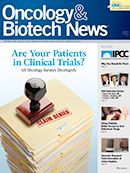Will 2010 Be the Year that Ariad Closes the Gap?
When companies talk about "narrowing the gap," they typically mean closing the distance that separates them from their leading competitor. At Ariad Pharmaceuticals, however, that expression has taken on a new meaning: narrowing the distance from development to market for its two most promising compounds.
When companies talk about “narrowing the gap,” they typically mean closing the distance that separates them from their leading competitor. At Ariad Pharmaceuticals, however, that expression has taken on a new meaning: narrowing the distance from development to market for its two most promising compounds. The Cambridge, Massachusetts-based biotechnology company has been in business for more than 15 years and has yet to bring a drug to market.
For several of those years, Ariad has been working doggedly on developing ridaforolimus, a small-molecule mTOR inhibitor, and AP24534, a pan-BRC-ABL inhibitor. In clinical trials, both agents have generated exciting data according to chairman and CEO Harvey Berger, MD. “We’re in a great place with our two drugs being very far along, and having an excellent chance of getting through clinical development and into the marketplace,” Berger said. Ariad is also working on a third drug, AP26113, which is an ALK inhibitor currently being investigated in preclinical trials.
Berger said Ariad expects to release results from the phase III SUCCEED trial, which is studying ridaforolimus in patients with metastatic soft tissue and bone sarcomas, during the second quarter or second half of 2010. If the results are positive, as anticipated based on data from phase II studies, Berger said Ariad plans to follow up soon after with the submission of a New Drug Application to the FDA. That filing will be an important step forward in the treatment of sarcoma, said Berger, because it has been more than 25 years since the FDA has approved any new treatment for the disease. “Having a drug like ridaforolimus that can compliment the available chemotherapies, that can add to the long-term benefits for these patients, can have a profound impact, we think, from a medical perspective,” Berger said.
The future of ridaforolimus as an effective treatment against cancer may not end with sarcoma. The drug is being studied in phase II trials for multiple indications, including breast, endometrial, prostate, and non—small cell lung cancer. “We have positive data from those trials as well,” Berger said. An ongoing phase II trial is evaluating ridaforolimus combined with trastuzumab (Herceptin) in women with pretreated HER2-positive metastatic breast cancer. Preliminary results presented at the San Antonio Breast Cancer Symposium in December 2009 indicated that the drug combination demonstrated clinical benefit, was well tolerated, and warranted additional study.
The enthusiasm over AP24534 stems from data presented at the American Society of Hematology annual meeting in New Orleans last December. In a phase I clinical proof-of-concept study, patients with resistant or refractory chronic myeloid leukemia (CML) or Philadelphia chromosome—positive acute lymphoblastic leukemia demonstrated hematologic, cytogenetic, and molecular responses with AP24534. Most notably, CML patients with the T315I mutant variant of the target protein, BCRABL, and other mutations that typically confer resistance to the approved tyrosine kinase inhibitors imatinib (Gleevec), nilotinib (Tasigna), and dasatinib (Sprycel) responded to AP24534. Jorge Cortes, MD, professor and deputy chair, Department of Leukemia, M.D. Anderson Cancer Center, who was the study’s principal investigator, said of the data, “Pending further clinical trials, AP24534 appears to represent a potential significant advance for CML patients who have become resistant or refractory to currently available therapies and who are in great need of new treatment options.”
Berger agrees. “That data was so compelling and so crystal clear that we really think it’s going to translate into a superb outcome for a pivotal trial,” he said. Berger believes Ariad will be able to move the compound through a human trial involving approximately 200 patients reasonably quickly and into regulatory filing.
Ariad’s optimistic outlook extends beyond the potential of these products. For the past 2-1/2 years, the company has maintained a partnership with Merck & Company, Inc. The large-cap pharmaceutical leader has been deeply involved in the development of ridaforolimus, contributing more than $200 million to help fund its journey to market.
Berger also highlighted the commercial benefits of the alliance. “Together, we will have a very strong presence in the marketplace,” he said. “We are very well connected here in the United States, but there is a global reach that Merck can provide as a large pharmaceutical manufacturer that we couldn’t do. And Merck post-merger with Schering-Plough is an even more substantial company.”
Berger said Ariad’s core strategy is to build a fully integrated oncology business in moving these new products forward. That strategy is intertwined with its vision of fostering breakthroughs in treatment that improve and prolong the lives of people with cancer. “We’re really focused on what makes patients with cancer have better and more fulfilling lives,” Berger said. “It’s all about the patient. And with sarcoma, it’s very clear that if the [ridaforolimus] trial is successful, this will make a difference to virtually every sarcoma patient in the world. It will change the paradigm for the treatment of advanced sarcomas.” It will also help Ariad finally close the gap between being a promising pharmaceutical company and being a successful one.




